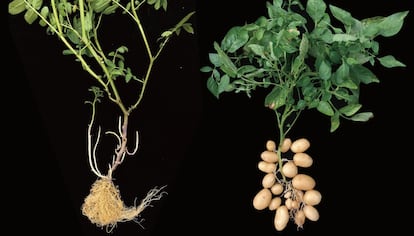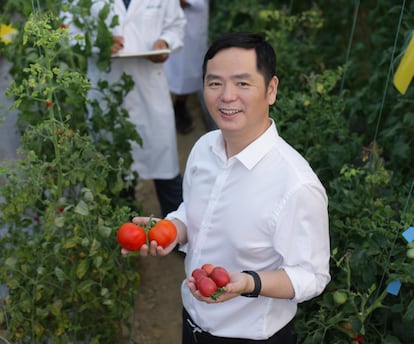Surprise in the plant family: the potato is the daughter of the tomato

American historian William McNeill dedicated a provocative essay to trying to demonstrate that the potato has changed world history. The plant, domesticated in what is now Peru some ten millennia ago, was the primary source of energy for the powerful Inca Empire and later for the Spanish conquistadors, who brought that unknown superfood to Europe around 1570. “Potatoes, by feeding rapidly growing populations, enabled a handful of European nations to dominate most of the world between 1750 and 1950,” McNeill argued a quarter of a century ago. The social history of the potato is well known, but its origins remained an enigma until now. An international team of scientists announced a surprise this Thursday: the potato is the daughter of the tomato.
“We have finally solved the mystery,” says Chinese geneticist Sanwen Huang , a research leader at the Shenzhen Institute of Agricultural Genomics. His team analyzed the intricate DNA of some 60 related species and discovered that the potato originated about nine million years ago from a natural cross in South America between a tomato plant and a potato (etuberosum) , a plant similar in appearance to the potato but without its characteristic edible tubers.
Huang and his colleagues emphasize that it was this genetic mix that allowed the emergence of these underground thickenings of the stems, which function as a nutrient store for the plant and are today a staple food for more than 1 billion people. A 170-gram potato provides135 kilocalories , half the recommended daily amount of vitamin C, and even four grams of protein with all the essential amino acids. Understanding the genetic intricacies that control their size and components is a key issue in global geopolitics, according to historian William McNeill. That's why China has focused on potato research.
The newly discovered relationship may be shocking to someone outside the agricultural field, explains geneticist Zhiyang Zhang . “It may be surprising because the tomato and potato you buy at the supermarket are quite different. However, what we actually eat are the fruits of the tomato plant and the underground tubers of the potato plant. It’s normal for two distinct organs to look so different, but the plants themselves—their leaves and flowers, for example—are similar,” reflects Zhang, the study’s first author. The potato plant looks even more like the Etuberosum, but genetic analysis reveals it to be more closely related to the tomato plant. “We were surprised that the potato is a descendant of the tomato,” admits Zhang, also a member of the Shenzhen Institute of Agricultural Genomics , a giant research center with 500 employees and affiliated with the Chinese government.

The authors emphasize that this innovative tuber, the nutrient-rich organ now called the potato, emerged at a key moment, in the midst of the uplift of the Andes mountain range . These new plants, equipped with underground thickenings on their stems, were able to adapt to the colder climates of the Andean mountains. They colonized diverse ecosystems and underwent an "explosive diversification," in the words of Huang, Zhang, and their colleagues. According to their figures, there are more than 100 wild potato species. Ten thousand years ago, the inhabitants of the Andes domesticated one of them, paving the way for the modern potato.
In 2011, Spanish biologist Salomé Prat led the team that discovered the genetic switch that tells plants when to produce tubers, depending on the hours of daylight: the SP6A gene . The new study shows that this key gene comes, surprisingly, from tomato plants. The mystery is what happens next, when, for example, the autumn sun activates the switch, emphasizes Prat, from the Center for Research in Agrigenomics in the Barcelona town of Cerdanyola del Vallès. “When the signal to form tubers arrives, what happens in that underground stem that makes it begin to thicken and accumulate starch and proteins? We don't know yet,” she explains. “If we manage to understand the set of necessary genes, in the future we could create plants that produce grains as well as tubers,” Prat continues. Potatoes and cereals in a single plant.
Huang and Zhang's team recalls that hybrid potato and tomato plants have already been created. The researchers cite a 1978 study by Spanish geneticist Marisol Sacristán , who died in 2023 at the age of 87. The scientist, from the Free University of Berlin, and two other colleagues managed to rudimentarily combine a cherry tomato plant and a potato plant almost half a century ago. "The ability exists. And now that we know they are so closely related, in the future we could have plants that produce tomatoes and potatoes, but that's still a long way off; we need to better understand the process," Prat says.

Tubers could provide the energy for the next global empire. “China has gone all in on potatoes and is going to wipe us all out. They've realized it's a super-productive crop: you can harvest a lot of potatoes with little land. For wheat, on the other hand, you need huge fields. If we improve the quality of potatoes now, for example, by making them higher in protein, it will become a superfood,” Prat argues. China is already the world's largest potato producer, with a cultivated area of 50,000 square kilometers , equivalent to the area of entire countries like Costa Rica and Slovakia.
A dozen Chinese institutions collaborated on the new study, published this Thursday in the journal Cell . Seven other centers from Canada, the United States, Germany, and the United Kingdom also participated. The authors are grateful for the help of Colombian scientist Susy Echeverría , who dedicated her doctorate at Imperial College London to trying to understand why the potato and tomato family is so diverse and why some of its membershave been so successful in colonizing different ecosystems around the world. “The most interesting point is not so much when the potato group originated, but how,” says Echeverría, who emphasizes that the development of tubers arose from a combination of genes from different lineages. If William McNeill was right and history repeats itself, whoever understands these enigmatic genetic intricacies of the potato will dominate the world.
EL PAÍS





